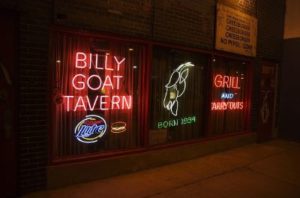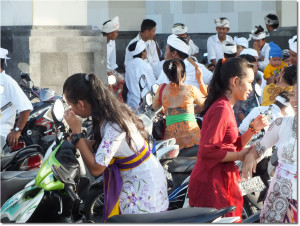 |
| A map of my walks. |
After leaving Kampung Bugis walking to the east comes the intersection of Jalan Diponegoro and Jalan Erlangga. Actually, Jalan Dipongegoro becomes Jalan Erlangga in that way that streets do here. Navigating any city in Bali is made more difficult by the fact that house and shop numbers do not necessarily change sequentially and one street suddenly becomes another without warning. Detailed maps may be of some help, but how many of us carry maps around with us? So out onto Jalan Erlangga; this is a short street. This part of it is narrow and often congested because of traffic coming from Jalan Diponegoro, which, as one of the main streets of Singaraja, gets a lot of traffic, and Jalan Pattimura which runs through Kampung Bugis and gets a lot of traffic because all of the trucks coming from the west have to be routed through Jalan Pattimura. Find a photo. A lot of cars and delivery trucks double park here which adds to the congestion.
Jalan Erlangga has a large furniture shop where we buy most of our furniture. We’ll occasionally run into foreigners from the Lovina area shopping for furniture there. This is not the expensive custom made furniture, but they have some nice beds and a few other pieces. One the south side of Erlangga is another furniture shop. We buy things there occasionally. Additionally, there are several automotive parts stores, a fishing/photography shop, a small grocery store selling dry goods and beverages, a baby shop and at several bicycle stores. Other buildings include a mosque and a store selling generators, hardware and other building tools.
 |
| Jalan Hasanuddin, Singarja Bali |
Jalan Erlangga continues on past the intersection with Jalan Imam Bonjol. Here, Jalan Erlangga becomes a wider two-way street. Both sides have a number of shops selling building supplies such as paint, plywood, ceramic tiles, tools, varnish, nails and bolts, cement, and a variety of other building materials. This section of Jalan Erlangga continues on about 200 meters until it reaches the entrance to the old harbor and the bridge; it then becomes Jalan Surapati. Right across from the entrance to the bridge on the south side of the street is the start of Jalan Hasanuddin. Like Jalan Imam Bonjol, Jalan Hasanuddin is a one-way street running south. A lot of the buildings on Jalan Hasanuddin are storage facilities for local businesses. There is a busy pharmacy, a dentist’s office and a pediatrician’s office close by. Going south a ways is a pet supply store. No pets, just supplies like cages, aquariums, food for any number of creatures, and cigarettes. Yes, this pet store sell cigarettes.
Jalan Hasanuddin continues on south until it curves to the west and joins up with Jalan Imam Bonjol. As I walked this short stretch, I could hear the screams and laughter of children. I looked up and noticed an elementary school. I expected that because of the noise level the kids would be out on recess, but they were safely tucked away inside the classrooms. A large bathroom and tile store sits right at the intersection of Hasanuddin and Imam Bonjol. We’ve bought a few faucets and a toilet from them. They have a small, but interesting selection of bathroom fixtures, including a large solar water heater. This kind of store wasn’t around in Singaraja when we were building each of our houses. To get Western-type building supplies, we had to go down to Denpasar, and even there, the selection was limited. Singaraja has become more Western friendly in terms of construction materials, and, even Indonesians are now buying Western-type furnishings for their homes. Recently we visited a neighbor’s house and were surprised to see that they had a Western toilet in their bathroom along with a fancy sink and cabinet set. Across the street is a fairly large building supply store that sells paint, wood, plastic piping and so on.
And just where Jalan Imam Bonjol ends and splits into two streets, Jalan Gajah Mada starts and leads south to Denpasar. Jalan Dr. Sutomo splits off to the west for a short distance and becomes Jalan A. Yani which heads off to Lovina. Right at this busy intersection (noticeable for the large statute that marks the intersection), Singaraja’s post office is located. Generally the post office isn’t too busy, and it now has a small ATM in the parking lot.
I follow Jalan Dr. Sutomo – it only runs about 150 meters at the most – over to Jalan Diponegoro. Jalan Dr. Sutomo has a mix of small businesses that sell books, household goods and electronics. There is also a small internet shop that I used a few times when my internet connection was out. Perhaps most importantly, Bank Central Asia is here just across from the south entrance to Singaraja’s main market. BCA has an ATM machine and inside it’s possible to change currency including traveler checks. A police post, a clothing store and a motorcyle store are also located here.







 I’ve been thinking about the question that is posed to me now and again (probably more frequently than now and again when I come to think about it) about why I live in Bali. I was just reading some comments on an expat forum where several members were discussing how much they disliked Bali now after living here for some time, with one writer being literate enough to sum it all up as “Bali sucks.” OK, the emotion there was pretty clear, and the frustrations that expats sometimes feel here aren’t just made up: there are lots of frustrations to life in Bali that can wear on people like traffic, corruption, visa problems, the education system, lack of an infrastructure sufficient for the population size, poor health care, scam artists and on and on. The issue is how to deal with these frustrations of everyday life, if indeed someone wants to deal with it at all.
I’ve been thinking about the question that is posed to me now and again (probably more frequently than now and again when I come to think about it) about why I live in Bali. I was just reading some comments on an expat forum where several members were discussing how much they disliked Bali now after living here for some time, with one writer being literate enough to sum it all up as “Bali sucks.” OK, the emotion there was pretty clear, and the frustrations that expats sometimes feel here aren’t just made up: there are lots of frustrations to life in Bali that can wear on people like traffic, corruption, visa problems, the education system, lack of an infrastructure sufficient for the population size, poor health care, scam artists and on and on. The issue is how to deal with these frustrations of everyday life, if indeed someone wants to deal with it at all.